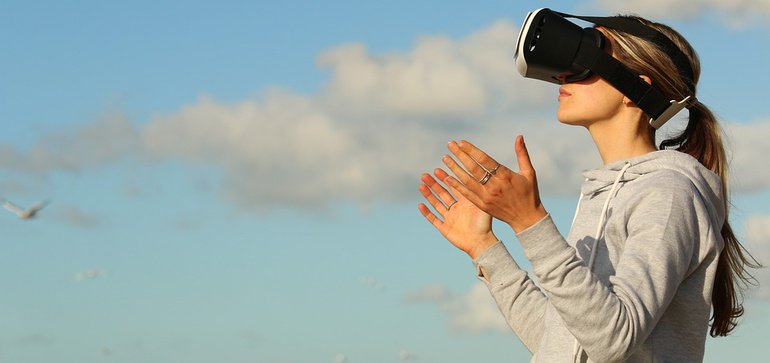Pina coladas are always good, but are they better on the beach?
Robin Dando, an associate professor at Cornell University’s Department of food science and director of the Cornell Sensory Evaluation Facility, thinks they are. And he’s brought virtual reality goggles and several bottles of pina colada mix to the Institute of Food Technologists’ annual conference to demonstrate it to the industry.
Dando is replicating research his lab has done about how people perceive taste. Participants wear the VR goggles, which put them in an immersive beach scene. They are first given pina colada mix, then bloody mary mix. They rate the way each one tastes. And then, with the goggles off and at tables in the middle of the show floor at the New Orleans Convention Center, they are offered a second sample of each and asked to rate the taste.
After one day of demonstrations at IFT, Dando said the hypothesis hasn’t exactly been proven.
“I would imagine that people would love a pina colada on the beach, but the idea of a bloody mary on the beach might be a little bit gross,” Dando told Food Dive, showing how the demonstration works. “But apparently, some people really love bloody marys. I’ve had several people say, ‘I always drink a bloody mary on the beach! ‘ ““
Of course, the demonstration isn’t being used for any research that will be published. After all, the bustling environment at IFT — with background noise of music and people talking, coupled with a cornucopia of different smells in the air — is hardly the kind of controlled space that should be used for scientific research, Dando said.
But the premise behind the experiment, which has drawn a lot of attention after studies appearing in the Journal of Food Science and Foods, is valid and, Dando said, quite a powerful thing to know.
“From an industry standpoint, this can help us understand how to market foods better,” he said. “Is this a food that is going to be enjoyed in a very formal setting, or is it something you’re just going to have on the dash of your car? … From a health standpoint, people make bad decisions around food, particularly around snacking. … If we can understand the decisions they make, perhaps we can nudge them toward healthier choices.”
For the first paper on how sensory aspects impact taste, Dando’s lab put the consumer in a VR-enabled barnyard and had the individual taste blue cheese. Next, the consumer was sitting on a VR park bench and tasted the same cheese. In the barnyard environment, where there are more distinctive smells, test subjects reported a more pungent taste from the cheese.
The second paper looked at how much the consumer liked the atmosphere and location. It was structured more like the IFT demonstration. Test subjects found themselves through VR in either a nice winery tasting room or a dive bar. They sampled champagne or Miller High Life, which calls itself “The champagne of beers.”
The hypothesis was that test subjects would like each beverage more in the place that they’d be more likely to drink it — champagne would be preferred at the winery, and the beer would be better in the bar. That was mostly borne out, though there was not a large preference for beer at the bar, Dando said. That study also asked consumers about their willingness to pay, and test subjects said they would pay more for the beer and wine at the tasting room than at the bar.
Dando said there has been some interest from the food and beverage industries in getting Cornell to perform the same type of research on their products. Commercial research isn’t the university lab’s priority, however. Instead, it has chosen to publish very detailed instructions on how manufacturers can replicate the test themselves.
The uniqueness of the process makes it a sought-after dimension to add to taste testing, Dando said.
“It adds extra versatility to a sensory test because sensory tests have been done the same way for as long as there has been sensory testing,” he said. “This adds a little bit more to your test. You can figure out not just how many people like it, but how much they like it in different situations.”
Source: Virtual reality demo shows how location can impact taste | Food Dive













